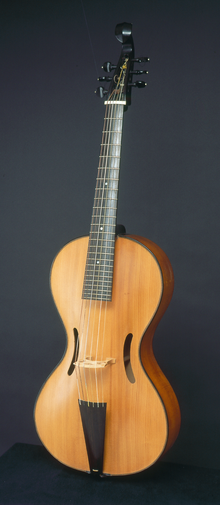Arpeggione
The arpeggione is a string instrument invented in 1823 by the Viennese violin maker Johann Georg Stauffer (* January 26, 1776 - January 24, 1853 ) , the characteristics of the guitar (body shape without protruding edge with flat bottom, metal frets, six strings in the tuning EAdghe ′) And the violoncello (string length, bridge height, playing position, bowing , vaulted top). The basic idea was to combine the construction principles of the guitar with the expressive possibilities and dynamic qualities of the bowed tone. At the same time as JG Stauffer, Peter Teufelsdorfer also built a similar instrument in Pest , called the guitare d'amour, bow guitar or sentimental guitar.
Musical use
The Arpeggione would certainly come as a curiosity long since forgotten, had Franz Schubert (1797-1828) not his Sonata for Arpeggione and Piano written that is listed quite often, the part of the Arpeggiones mostly from a cello , rare of a Viola or a guitar .
In 1962, Alfred Lessing discovered Dr. Bitterer performed an arpeggione in Stuttgart, which is attributed to Anton Mitteis, Leitmeritz, 2nd quarter of the 19th century. The collection was later acquired by the Musikinstrumentensammlung Preußischer Kulturbesitz , Berlin. In 1968 Lessing had a replica of this arpeggion made in order to obtain a regularly playable instrument (see picture). The harpsichordist Fritz Neumeyer suggested an authentic performance of the Arpeggione sonata. The first concert in a series took place on October 17, 1971 in Wasenweiler in the Neumeyer Collection ( Alfred Lessing , Arpeggione and Rolf Junghanns , fortepiano). The same line-up played a public concert on February 10, 1972 in the Musikinstrumentenmuseum Prussischer Kulturbesitz, where Lessing (supported by Alfred Berner) was able to play the original instrument.
Other interpreters such as Gerhart Darmstadt and Nicolas Deletaille have adopted the instrument, and numerous new compositions have been created for it.
Another replica of the instrument from the holdings of the Musikinstrumenten-Museum Berlin was made for practice purposes. Gerhart Darmstadt used this replica for his recording of the Sonata for Arpeggione and Piano in A minor by Franz Schubert with an arpeggione .
Another recording of Schubert's Arpeggione Sonata on a recreated arpeggione was made by Nicolas Deletaille and Paul Badura-Skoda .
See also
Recordings
- Music for arpeggione. ( Alfred Lessing : Arpeggione, Jozef De Beenhouwer: fortepiano , Harald Mohs: guitar ). Sound carrier "Music for Arpeggione" in the catalog of the German National Library
- The arpeggione. ( Gerhart Darmstadt : Arpeggione, Egino Klepper: fortepiano , Björn Colell: romantic guitar . Works by Franz Schubert , Ludwig van Beethoven , Louis Spohr , Bernhard Romberg , Frédéric Burgmüller ). Cavalli Records CCD 242 (CD). Sound carrier "The Arpeggione" in the catalog of the German National Library
- Franz Schubert: Sonata for Arpeggione and Piano D821 / String Quintet D956. Nicolas Deletaille, Arpeggione and Paul Badura-Skoda (piano). Fuga Libera (CD).
Web links
References and comments
- ↑ The gender assignment is unclear. Apart from the masculine, the feminine and neuter are used with roughly equal frequency. The Duden suggests "the arpeggione".
- ^ Copyright dispute
- ↑ a b Arpeggione at the State Institute for Music Research Prussian Cultural Heritage Berlin
- ↑ Thomas Schiegnitz: The Arpeggione of the Musical Instrument Museum - making it possible to play again through a replica. Yearbook of the State Institute for Music Research Prussian Cultural Heritage. JB Metzler, Stuttgart 2001, p. 282 ( online version , PDF; 909 kB, accessed on November 25, 2009).
